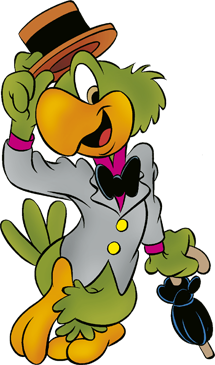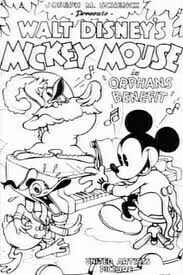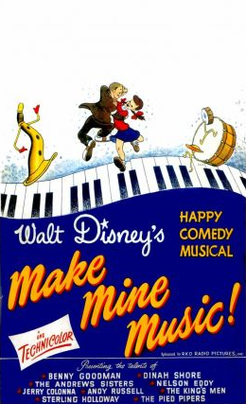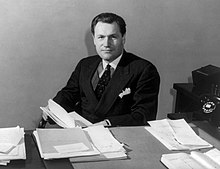
José "Zé" Carioca is a cartoon anthropomorphic parrot created by the Brazilian cartoonist José Carlos de Brito and shown to Walt Disney on his trip to Rio de Janeiro in 1941. The Walt Disney Company then incorporated the idea, being introduced in the 1942 film Saludos Amigos as a friend of Donald Duck, described by Time as "a dapper Brazilian parrot, who is as superior to Donald Duck as the Duck was to Mickey Mouse." He speaks Portuguese with a Brazilian accent. He returned in the 1944 film The Three Caballeros along with Donald and a Mexican rooster named Panchito Pistoles. José is from Rio de Janeiro, Brazil.

The Three Caballeros is a 1944 American live-action and animated musical propaganda anthology film produced by Walt Disney and released by RKO Radio Pictures. The film premiered in Mexico City on December 21, 1944. It was released in the United States on February 3, 1945 and in the United Kingdom in March 1945. It marks the tenth anniversary of Donald Duck and plots an adventure through parts of Latin America, combining live-action and animation. This is the second of the six package films released by Walt Disney Productions in the 1940s, following Saludos Amigos (1942). It is also notable for being one of the first feature-length films to incorporate traditional animation with live-action actors.

Orphan's Benefit is an American animated short film produced by Walt Disney Productions in black-and-white. It was first released in 1934 and was later remade in Technicolor in 1941 under the corrected title Orphans' Benefit. The cartoon features Mickey Mouse and his friends putting on a vaudeville-style benefit show for a group of unruly orphans. It contains a number of firsts for Disney, including the first time in which Mickey Mouse and Donald Duck appear together, and was the 68th Mickey Mouse short film to be released, and the sixth of that year. It was also the cartoon which had the first story to be written that featured Donald Duck, though it was the second Donald Duck short to be produced and released, after The Wise Little Hen.

Fun and Fancy Free is a 1947 American animated musical fantasy anthology film produced by Walt Disney and Ben Sharpsteen and released on September 27, 1947 by RKO Radio Pictures. The film is a compilation of two stories: Bongo, narrated by Dinah Shore and loosely based on the short story "Little Bear Bongo" by Sinclair Lewis; and Mickey and the Beanstalk, narrated by Edgar Bergen and based on the "Jack and the Beanstalk" fairy tale. Though the film is primarily animated, it also uses live-action segments starring Edgar Bergen to join its two stories.

Make Mine Music is a 1946 American animated musical anthology film produced by Walt Disney and released by RKO Radio Pictures on April 20, 1946.
"Aquarela do Brasil", written by Ary Barroso in 1939 and known in the English-speaking world simply as "Brazil", is one of the most famous Brazilian songs.

Ary Evangelista de Resende Barroso was a Brazilian composer, pianist, soccer commentator, and talent-show host on radio and TV. He was one of Brazil's most successful songwriters in the first half of the 20th century. Barroso also composed many songs for Carmen Miranda during her career.
This is a list of appearances made by Donald Duck in Disney features and cartoons.
John Ryan Kinney was an American animator, director and producer of animated shorts. Kinney is the older brother of fellow Disney animator Dick Kinney.
Paul J. Smith was an American music composer and violinist best known for his work at Disney.
South of the Border with Disney is a 1942 Disney live-action short documentary film. It was shot on the same occasion as the live-action segments of Disney's Saludos Amigos, when Walt Disney and a group of eighteen artists, musicians and writers traveled to South America looking for inspiration for creative projects. Disney's trip was conducted under the auspices of the Office of the Coordinator of Inter-American Affairs (CIAA) in order to promote cooperation between the United States and various South American nations.

Clock Cleaners is a 1937 American animated short film produced by Walt Disney Productions and released by RKO Radio Pictures. The cartoon follows Mickey Mouse, Donald Duck, and Goofy working as janitors in a tall clock tower. The film was directed by Ben Sharpsteen and features original music by Paul Smith and Oliver Wallace. The voice cast includes Walt Disney as Mickey, Clarence Nash as Donald, and Pinto Colvig as Goofy. It was the 97th short in the Mickey Mouse film series to be released, and the eighth for that year.
The second wave of Walt Disney Treasures was released December 3, 2002. This was the final wave with the tin's individual number embossed on the tin.

Hawaiian Holiday is a 1937 American animated short film produced by Walt Disney Productions and released by RKO Radio Pictures. The cartoon stars an ensemble cast of Mickey Mouse, Minnie Mouse, Pluto, Donald Duck, and Goofy while vacationing in Hawaii. The film was directed by Ben Sharpsteen, produced by John Sutherland and features the voices of Walt Disney as Mickey, Marcellite Garner as Minnie, Clarence Nash as Donald, and Pinto Colvig as Goofy and Pluto. It was Disney's first film to be released by RKO, ending a five-year distributing partnership with United Artists.

The Whalers is a cartoon produced by Walt Disney Productions, released by RKO Radio Pictures on August 19, 1938, and featuring Mickey Mouse, Donald Duck and Goofy.

The Hollywood Musicals is an album by American pop singer Johnny Mathis and American composer/conductor Henry Mancini that was released on October 17, 1986, by Columbia Records. This project heralded Mathis's return to the genre of traditional pop, which he would revisit occasionally over the next few decades.

Walt & El Grupo is a 2009 American documentary film written and directed by Theodore Thomas.

José do Patrocínio Oliveira, known by the pseudonym Zé Carioca, was a Brazilian musician and voice actor.

Contrary Condor is a 1944 Donald Duck short film by Walt Disney Productions and RKO Radio Pictures.














